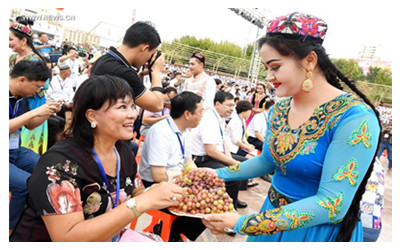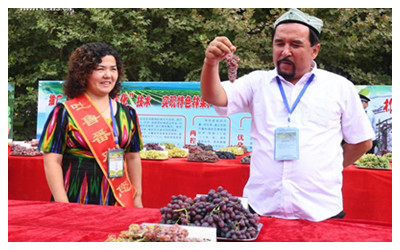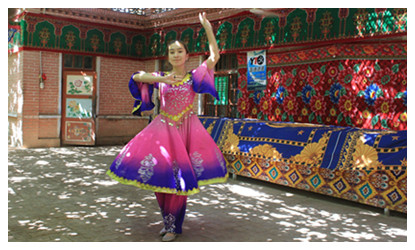Skype: neodalle-travel
Tel: +86 135 7447 2266
E-mail: sales@visitaroundchina.com
 Grape is a product that Turpan and even Xinjiang are famous for. In honor of the Silk Road’s openness for about 2,100 years, the grape festival has been held in Turpan from August 20 to September 5 every year since 1990. Hundreds of varieties of grapes hang on the vines, and are ready for picking, drying, and processing. Expect plenty of cultural performances in the rural countryside. Turpan is an oasis town, covered in vine trellises, where every household has some business in grape growing, and the local markets are full of sweet dried raisins.
Grape is a product that Turpan and even Xinjiang are famous for. In honor of the Silk Road’s openness for about 2,100 years, the grape festival has been held in Turpan from August 20 to September 5 every year since 1990. Hundreds of varieties of grapes hang on the vines, and are ready for picking, drying, and processing. Expect plenty of cultural performances in the rural countryside. Turpan is an oasis town, covered in vine trellises, where every household has some business in grape growing, and the local markets are full of sweet dried raisins.
A girl serves grapes to tourists at the opening ceremony of the annual grape festival in Turpan, Northwest China's Xinjiang Uygur autonomous region, Aug 26, 2017. A total of 216 different kinds of grapes were shown at the festival. [Photo/Xinhua]
 As an important transportation junction on the ancient Silk Road, Turpan absorbs various culture types of Central Asia and Eastern Europe, which boasts an abundance of cultural relics and historic sites, peculiar folk customs of Uygur minority and the marvelous landscape of desert oasis. Thanks to these, Turpan becomes a hot attraction for travelers from home and abroad to appreciate the ancient civilization of the Western Regions and the vast desert landscape.
As an important transportation junction on the ancient Silk Road, Turpan absorbs various culture types of Central Asia and Eastern Europe, which boasts an abundance of cultural relics and historic sites, peculiar folk customs of Uygur minority and the marvelous landscape of desert oasis. Thanks to these, Turpan becomes a hot attraction for travelers from home and abroad to appreciate the ancient civilization of the Western Regions and the vast desert landscape.
A tourist looks at the grapes at the opening ceremony of the annual grape festival in Turpan, Northwest China's Xinjiang Uygur autonomous region, Aug 26, 2017. A total of 216 different kinds of grapes were shown at the festival. [Photo/Xinhua]
 During the annual Turpan Grape Festival, there are a number of interesting and exiting activities. On the festival, a large-scale firework display, and a singing and dancing gala mark the opening of the festival on the first night. Events on the festival include a Wedding in the Uygur style, mashlap (lively and humorous folk dance), nazkum (witty art performance), Koco style songs and dances, Hami-melon competition, trade negotiations, tour of the Street of Grapes and Melons.
During the annual Turpan Grape Festival, there are a number of interesting and exiting activities. On the festival, a large-scale firework display, and a singing and dancing gala mark the opening of the festival on the first night. Events on the festival include a Wedding in the Uygur style, mashlap (lively and humorous folk dance), nazkum (witty art performance), Koco style songs and dances, Hami-melon competition, trade negotiations, tour of the Street of Grapes and Melons.
Turpan Silk Road Grape Festival is well-known across the coutry. Since its debut in 1990, it has been a way to show Turpan's development. In the festival people can eat grapes, melons, watermelons, mutton shashlik, drink wine, enjoy watching folk dances and listening to songs.
 Ask Questions ?
Ask Questions ?